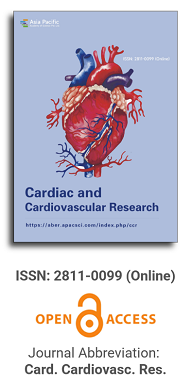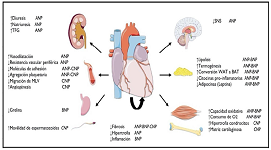
Asia Pacific Academy of Science Pte. Ltd. (APACSCI) specializes in international journal publishing. APACSCI adopts the open access publishing model and provides an important communication bridge for academic groups whose interest fields include engineering, technology, medicine, computer, mathematics, agriculture and forestry, and environment.

Issue release: 30 June 2024
Cardiovascular disease (CVD) is a leading cause of morbidity and mortality worldwide, accounting for a significant proportion of healthcare costs. It is a major public health concern, and early detection and prevention are critical for reducing its burden. Several risk factors for CVD have been identified, including age, sex, genetics, hypertension, diabetes, smoking, and physical inactivity. Despite the identification of several risk factors, there is still a lack of understanding of the underlying mechanisms that contribute to CVD development. This study aimed to investigate the potential predictors of CVD and identify novel biomarkers that could be used for early detection and prevention. The study explored pre-processing strategies, including Synthetic Minority Oversampling Technique (SMOTE), Z-Score Normalization, and Adaptive Synthetic Sampling (ADASYN), to address class imbalance and enhance model performance. The dataset consisted of medical images labeled with different cardiovascular diseases. By integrating the strengths of Support Vector Machines (SVM) classification and Linear Discriminant Analysis (LDA), Principal Component Analysis (PCA), and PCA with ReliefF feature retrieval methods, the study investigated various feature extraction approaches for classifying cardiovascular diseases.
Issue release: 30 June 2024
Among the risk factors for dry mouth, or xerostomia, are both estrogen deficiency in women during menopause and the use of medications with xerogenic properties. Until now, it has not been clearly determined, whether dryness in the oral cavity in women during menopause is only associated with subjective sensations or is accompanied by qualitative and quantitative changes in mixed saliva. To determine the frequency and nature of xerostomia syndrome in women during menopause with high and extremely high risk of cardiovascular diseases. The study involved 35 patients (with subjective sensations of dryness in the oral cavity) and 20 apparently healthy women. All study participants were questioned for any dental complaints, and the quantitative indicators of the oral fluid were assessed. An individualized oral hygiene complex and a moisturizing gel were prescribed as correction of the subjective signs of xerostomia. The follow-up visit was carried out after 1 month. The patients in natural menopause felt slight subjective manifestations of dry mouth confirmed by objective decrease in salivary secretion; whereas in most cases subjective dryness in the oral cavity is accompanied by normal secretion. The prescribed complex for correction of dental complaints ensures decrease in the subjective signs of dryness, decrease in taste distortion and halitosis.
Issue release: 30 June 2024
Background and Aim: Ivabradine is indicated in chronic heart failure (HF) and reduced ejection fraction (EF) of < 35% and resting heart rate (HR) of > 70 bpm. However, role of Ivabradine in acute decompensated chronic HF (ADCHF) is not well known. The aim of this study was to evaluate one-year outcomes of ADCHF patients discharged with and without Ivabradine. Materials and Methods: This is a prospective observational cohort study of ADCHF patients from January 2016 to January 2018. Main exclusion criteria was new onset de-novo acute HF, those with EF > 50% and atrial fibrillation. Data were analysed from 130 patients who were discharged with (62 patients) or without Ivabradine (68 patients). The primary end points were one-year re-hospitalization and cardiovascular mortality between two groups. Results: The mean age of patients were 56 ± 15 years and 61 ± 17 years between Ivabradine and Non-ivabradine groups. EF upon discharge was 37.48% ± 5.34% vs 40.01% ± 8. 12%, with p-value of 0.036. At discharge, higher HR was noted in patients with Ivabradine 84 ± 13 bpm compared to 77.84 ± 12. 13 bpm in patients without Ivabradine (p-value = 0.006). After a year, HR in Ivabradine group was low compared to non-Ivabradine group, but was not statistically significant, 66.15 ± 8 vs. 69.29 ± 11.3 bpm, respectively. In the Ivabradine group 27.4% of patients visited emergency room (ER) more than once compared to 60.2 % without Ivabradine (p-value = 0.0001). 9.7% of patients in Ivabradine group required one readmission compared to 55.9% without Ivabradine (p-value = 0.0001). Conclusions: In ADCHF patients there was significant reduction in ER room visit and re-admission rate in patients discharged with Ivabradine. Hence Ivabradine therapy may be considered in patients with ADCHF with EF < 50% and HR > 70 bpm to prevent re-hospitalization and save hospitalization costs.
Issue release: 30 June 2024
The optimal strategy for patients with in-stent restenosis (ISR) is controversial. We aimed to compare the effects of a drug-coating balloon (DCB) and drug-eluting stent (DES) in ISR treatment. Clinical trials were extensively collected, and retrieved items were screened for inclusion. Both clinical (major adverse cardiac event (MACE); myocardial infarction (MI); and target lesion revascularization (TLR) and angiographic (minimal lumen diameter (MLD), and stenosis relative to reference lumen diameter (SRLD) endpoints were extracted and compared. MACE and MI were not significantly different between the groups. Pooled results of TLR showed a marginal effect that DES was superior to DCB (13.50% for DCB vs. 11.17% for DES, RR = 1.256, 95% CI: 0.997 to 1.583, P = 0.053), with heterogeneity across studies (I2 = 42.0%, Cochrane Q-test = 0.069). Meta-regression identified bare metal stent (BMS) or drug eluting stents (DES) implanted in the previous intervention and proportions of diabetes in the DCB group as sources of heterogeneity. DES implantation also significantly improved angiographic outcomes (WMD for MLD: −0.318, 95% CI: −0.424 to −0.213, P < 0.001; WMD for SRLD: 6.164%, 95% CI: 4.915% to 7.412%, P < 0.001). All DES, including everolimus-eluting ones, did not benefit BMS-ISR patients compared with DCB treatment. DES implantation, which is superior to DCB angioplasty only in DES-ISR patients, should be preferred in the DES-ISR population to reduce TLR. DCB may be preferred in BMS-ISR to avoid increasing stent layers.
Issue release: 30 June 2024
Endocarditis is a rare and potentially fatal infection of the endocardium. Bartonella endocarditis is an emerging disease that causes serious complications and high rates of mortality. Due to the fastidious nature of Bartonella species and their high degrees of antibiotic susceptibility, cultures of clinical samples most often remain sterile. The best specimens for polymerase chain reaction amplification are seldom available. The diagnosis of Bartonella infections relies mainly on serological methods. We report the case of a 58-year-old woman with dyslipidemia who presented with nocturnal fever, polyarthralgia, sweats and weight loss. The diagnosis of Bartonella endocarditis was confirmed by an indirect immunofluorescence assay. Medical treatment alone was efficient for our patient without any surgery.
Issue release: 30 June 2024
Single coronary artery is a rare congenital condition which entails one artery to supply blood to the entire myocardium. A case of single coronary artery in a patient diagnosed with tachycardia-induced cardiomyopathy is discussed. The focus of this case is to present the clinical implications of this coronary anomaly.

Prof. Prakash Deedwania
University of California,
San Francisco, United States





 Open Access
Open Access